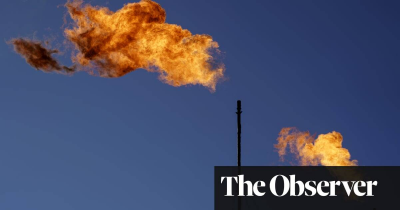The Guardian-Greenhouse gas emissions soar with China US and India most at fault
December 3, 2023 4 min 847 words
这篇报道揭示了自2015年巴黎气候协定签署以来,中国、美国和印度在电力和能源生产方面引发的温室气体排放急剧增加。数据显示,甲烷排放上升,尽管100多个国家承诺减少这种气体。令人担忧的是,许多国家和企业未能准确报告排放,违反了巴黎协定的义务。气候追踪项目利用卫星图像和人工智能软件准确识别全球排放源,揭示国家和企业对排放的报告与实际行为存在不一致。报道指出,中国煤矿是2021年至2022年甲烷排放增加的主要原因,但中国已与美国合作制定减少甲烷的计划。科学家认为,大幅削减甲烷是短期内避免全球变暖最严重影响的最佳机会。报道还指出,来自石油和天然气生产的甲烷燃烧也是排放的“重要和广泛来源”。然而,即便有50多家石油和天然气公司签署了“脱碳加速器”,减少气候影响,但环保人士认为这不够,并表示难以追责。最让人担忧的是,航空业和道路交通排放在疫情封锁后显著反弹,呼吁更为切实的法律协议。这篇报道警示我们,应对气候变化需要更加坚决的全球行动和企业责任。
Electricity generation in China and India, and oil and gas production in the US, have produced the biggest increases in global greenhouse gas emissions since 2015, when the Paris climate agreement was signed, new data has shown.
Emissions of methane, a greenhouse gas 80 times more powerful than carbon dioxide, have also risen, despite more than 100 countries signing up to a pledge to reduce the gas, according to data published on Sunday by the Climate Trace project.
The data shows that countries and companies are failing to report their emissions accurately, despite obligations to do so under the Paris agreement. More than 190 countries have been meeting in Dubai since Thursday in an attempt to put the world on track to meet the Paris goal of limiting global temperature rises to 1.5C above pre-industrial levels.
At the core of the Cop28 UN climate summit in Dubai is a process known as the “global stocktake” – an assessment of progress towards meeting the emissions cuts needed to stay within the 1.5C limit. Many countries, however, have failed to make updates.
Al Gore, a founder of the Climate Trace initiative, said: “Climate Trace is filling a vacuum that is presently virtually devoid of accurate information. We can break down exactly where emissions are coming from, facility by facility. If the problem is greenhouse gas emissions, it only makes sense to find out where they’re coming from.”
He said the UN was able to use the data, as were companies seeking to make accurate reports of their own emissions. Climate Trace uses satellite images and AI software to pinpoint the sources of emissions with a high degree of accuracy around the world, and has uncovered discrepancies between countries’ and companies’ reporting of emissions and their actual behaviour.
The new data showed coal mines from China were responsible for a large proportion of the increase in methane emissions between 2021 and 2022. China has signed a new pledge to include methane in its national climate plans for the first time, and is collaborating with the US on ways to reduce methane.
Scientists say sharp cuts to methane are the best chance of staving off the worst impacts of global heating in the short term. According to estimates, cuts to methane and other short-lived pollutants could reduce global temperature increases by as much as 0.3C.
Durwood Zaelke, president of the Institute for Governance and Sustainable Development, hailed cooperation on methane at the Cop28 summit. “[This] may just make it possible to keep 1.5C alive,” he said. “Methane is the blowtorch that is boiling the planet. Turn it off, and you immediately turn down the heat.”
Flaring of methane from oil and gas production was also “a significant and wide-ranging source of emissions”, the Climate Trace project found. Cracking down on flaring would offer a quick way to make substantial cuts in methane.
More than 50 oil and gas companies at Cop28 signed up to a “decarbonisation accelerator” by which they will reduce the climate impact of their operations, though they have not pledged to reduce their output. Climate campaigners said the deal did not go far enough, and its voluntary nature meant it would be difficult to hold the companies to account.
David Tong, global industry campaign manager at pressure group Oil Change International, said: “[The global decarbonisation accelerator] is a dangerous distraction from Cop28. We need legal agreements not voluntary pledges. The science is clear: staying under 1.5C global warming requires a full, fast, fair and funded phase-out of fossil fuels, starting now.”
Climate Trace data also revealed that emissions from aviation have bounced back strongly since the Covid lockdowns: carbon from international flights rose by 74% between 2021 and 2022, and from domestic flights by 18% over the same period. Road transport emissions also increased, by 3.5% – probably a result of the rise in SUV sales.
There was also good news. Deforestation is dropping in key regions, with emissions from the degradation and destruction of forests in the Congo Basin dropping by up to 19% in 2022, compared with the previous year.
Gavin McCormick, a co-founder of Climate Trace and executive director of environmental nonprofit WattTime, said: “By harnessing the power of AI and machine learning paired with the right data from satellites and beyond, our models are giving us a picture of the world we’ve never seen before. And it’s allowing us to make climate progress in a way some never believed possible.”
• Cop28: Can fossil fuel companies transition to clean energy?
On Tuesday 5 December, 8pm-9.15pm GMT, join Damian Carrington, Christiana Figueres, Tessa Khan and Mike Coffin for a livestreamed discussion on whether fossil fuel companies can transition to clean energy. Book tickets here or at theguardian.live

